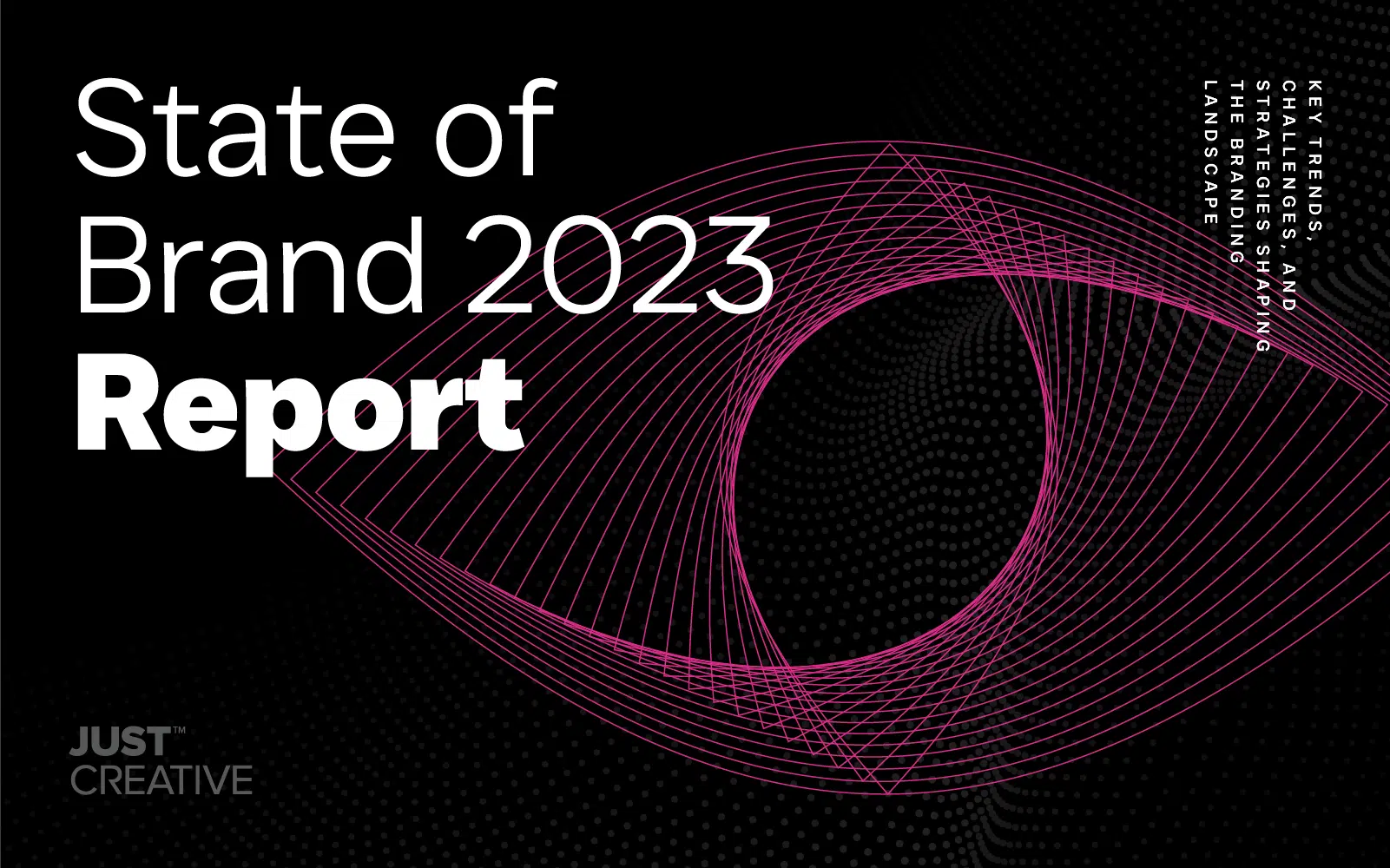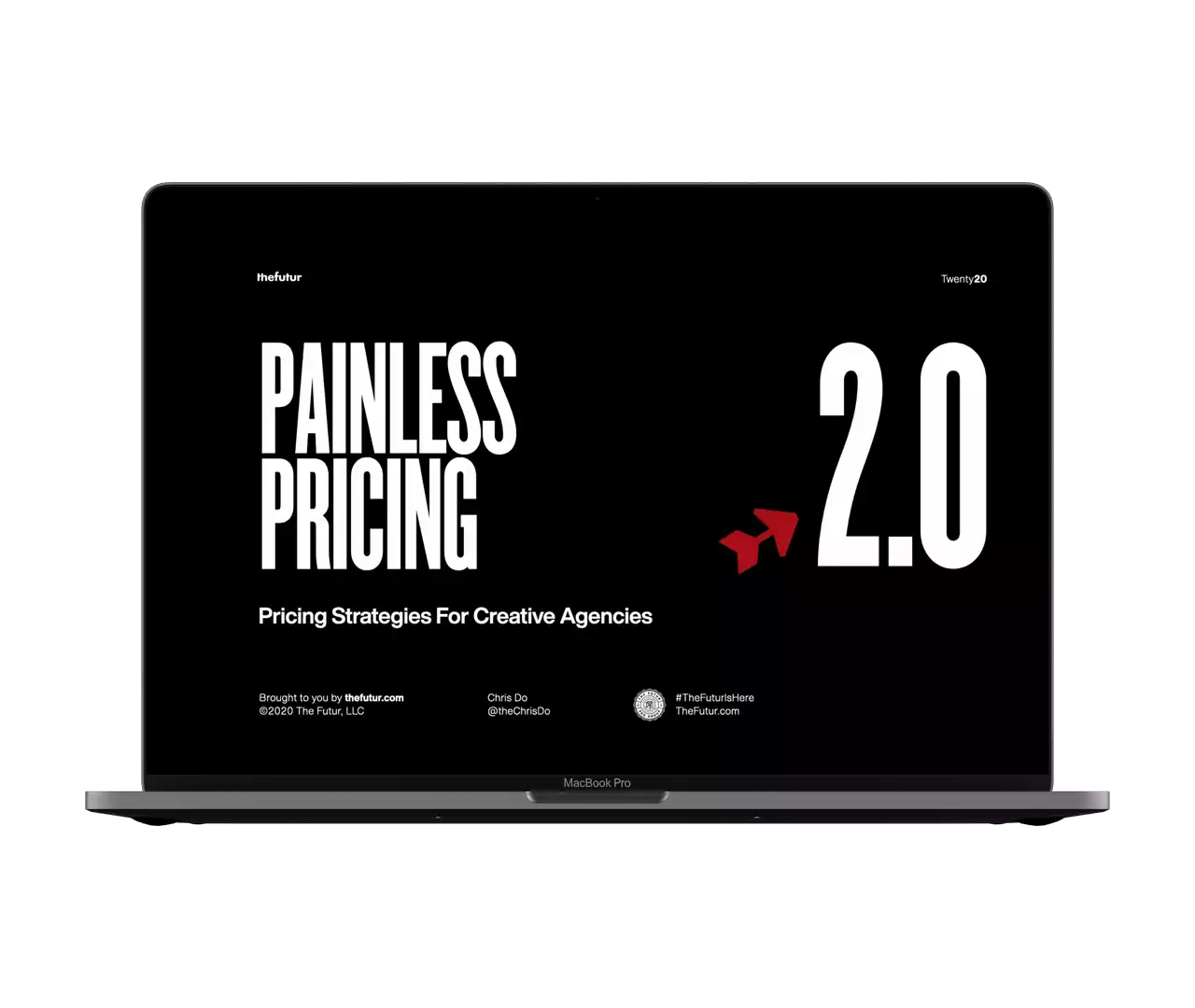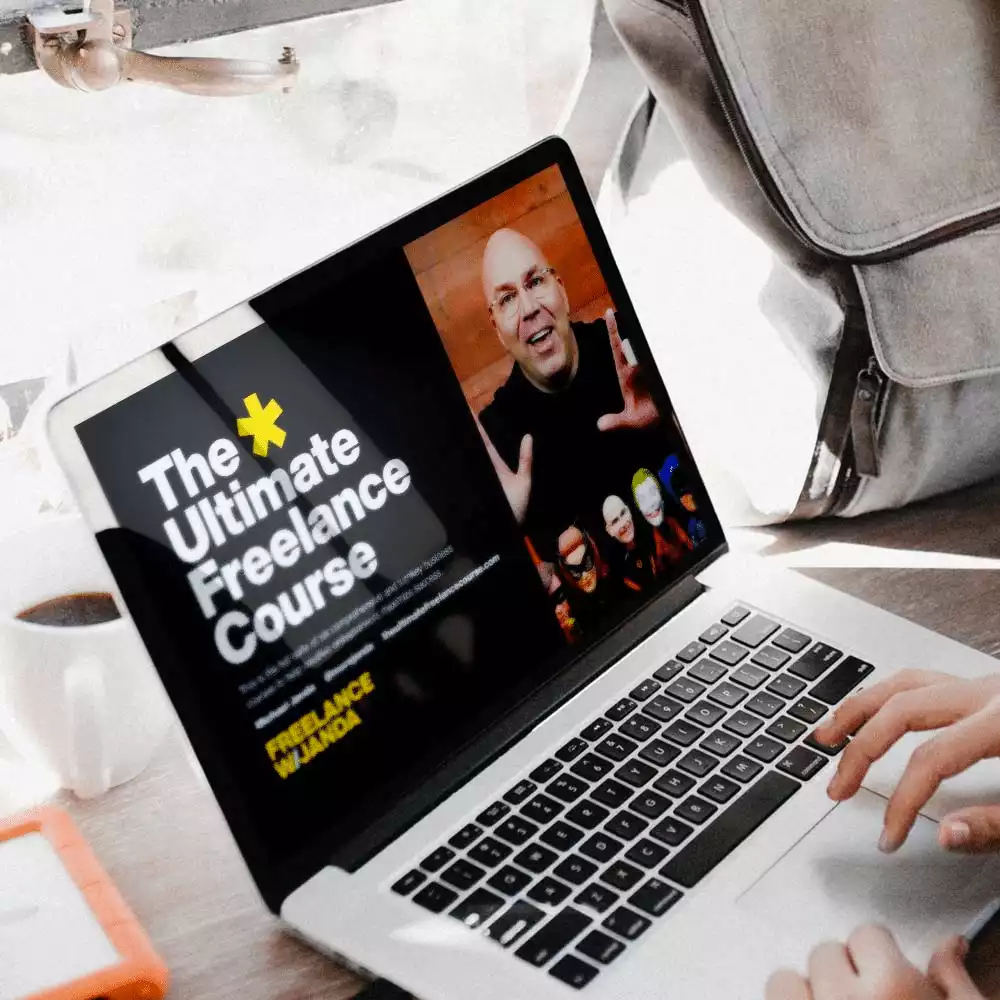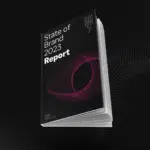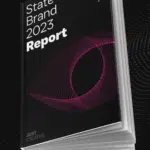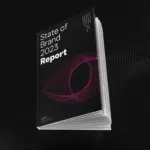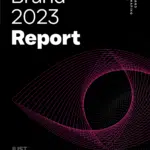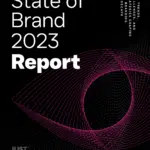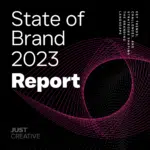Key Trends, Challenges, and Strategies Shaping The Branding Landscape
The world of branding is in constant flux of change. The rise of AI, post-COVID market shifts, and economic downturns are all impacting the industry like never before.
In the midst of these changes, branding professionals are striving to keep pace with the rapidly evolving landscape and advance their careers. This makes us wonder:
- How are they keeping up with these changes?
- What’s hindering their growth?
- And what visions do they hold for the future?
All these questions are pivotal for assessing the trajectory of the industry and, in turn, help branding professionals grow more confidently. So we decided to shed a spotlight on the present state of affairs in the branding industry with a focus on:
In this report, we have compiled the key insights and relevant take aways in collaboration with ContentMarketing.io.
You’ll learn how the industry is operating and how it is catching up with AI using key tools. You will also discover the tactics, metrics, and resources that power today’s branding professionals.
Let’s dive into the State of Brand 2023 Report.
Download the PDF Report
Update October 30: After many requests, we have now made a printable PDF version of the report. You can access the PDF report in our Branding Briefcase. Simply enter your email below.
State of Brand Survey 2023 Findings
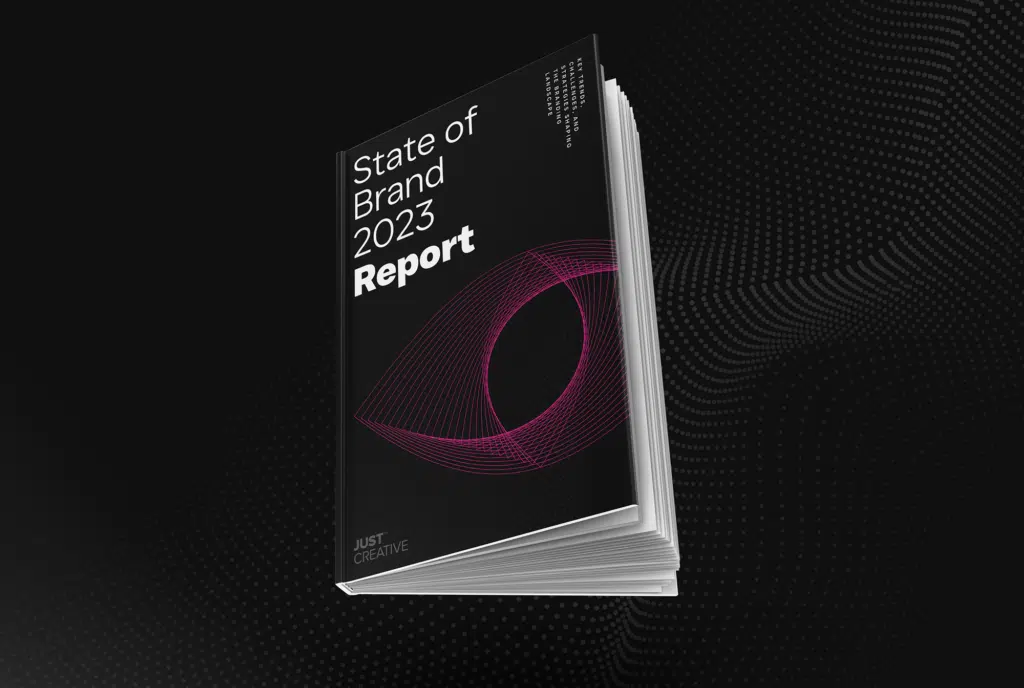
To gain a comprehensive understanding, we surveyed 267 professionals engaged in branding.
These include self-employed branders, in-house branding professionals, independent consultants, and founders – basically, all those who are steering the field in various capacities.
(A breakdown of who we surveyed is found further below.)
Here’s a snapshot of what we found:
Pricing Strategies
80% of branders price their projects based on the time and effort it takes.
37 % of branders utilize hourly rates for pricing. 69% use fixed pricing.
Only 35.2% of the respondents opt for value-based pricing for their work.
The majority (50%) of branding projects fall between the $500 and $5000 range.
Client Acquisition
The primary methods for acquiring clients are referrals and word of mouth (86.1%). Free consultations are offered by 21% of branders.
Networking and relationship building (71.5%) emerged as the second most effective client acquisition tactic after referrals.
AI Integration
70.4% of branding professionals believe AI will make their work easier, and are open to integrating AI tools like ChatGPT, Adobe Software, and Midjourney into their branding processes.
Some branding professionals express concerns that tools like Canva (38.6%) and AI may challenge traditional design services, requiring continuous innovation to stand out.
Future of Branding
Branders believe authenticity (74.5%) and personalization (58.8%) will drive the future of branding. Sustainability, emotional branding, and ethical branding are also important considerations.
Purpose-driven branding (57.3%) and emotional branding (49.4%) emphasize the growing importance of creating meaningful and emotionally resonant brand experiences.
Challenges
The main challenges for branding professionals include:
- finding new clients,
- educating clients about branding’s value,
- pricing structure,
- increasing competition,
- and the influence of AI.
Respondents stress the need for more education and awareness among businesses about the broader value of branding beyond visuals, indicating a gap in understanding.
Success Metrics
34% of branders do not measure the success of their branding projects. Customer satisfaction scores (39.3%) and brand awareness metrics are the most popular methods for measuring success.
Email marketing (7.9%) is underutilized as a success metric, suggesting an opportunity for branding professionals to leverage this powerful communication channel.
Income Streams
About 20% of branders solely rely on their primary source of income, while others explore additional avenues such as consulting (18.8%) and selling digital products (16.4%).
Only around 7% of branders have developed online courses as an additional earning avenue, showing a relatively untapped potential for knowledge monetization.
sponsored message
Tool Usage
For business operations, the payment tool PayPal (47.6%) and the accounting tool Quickbooks (14.6%) were the most popular among our respondents.
Adobe Creative Suite is widely used (90%), followed by tools like Figma and Procreate. Canva is gaining popularity (38.6%) for its easy-to-edit templates.
Legal Knowledge
Nearly 40% of branding professionals feel less confident about their knowledge of legalities like copyrights and intellectual property.
Learning and Development
90% of branders are seeking feedback from clients to continously learn and enrich themselves. Resources for skill enrichment included courses by The Futur, online publications, books, podcasts and influencers like Chris Do, Seth Godin and Jacob Cass.
Project Type and Duration
Brand identity (18.1%), logo design (17.8%), and brand strategy (14%) are the top three project types that branding professionals commonly work on, showcasing the core focus of their expertise.
Medium-scale projects spanning 4-8 weeks are the most prevalent (28.1%), followed by small-scale projects (less than 2 weeks) at 23.8%, showcasing the industry’s project duration distribution.
Branders who priced projects over $20,000 often reported comprehensive, complex, or extensive projects lasting 4-6 months or more (50%), highlighting the correlation between pricing and project scale.
Diversification and Differentiation
Branders differentiate themselves through client experience (90%), niche specialization, process innovation, and unique design style, signaling a multifaceted approach to standing out in a competitive landscape.
Who Took This Survey?
Branding is a pivotal component for businesses worldwide to build a unique identity. No matter the location, the demand for skilled branders remains consistent.
So, we reached far and wide with this survey to really understand what’s happening in the industry. From East to West and North to South of the Earth, we covered 25 countries.
Nearly 30% of our respondents were from the US, 9.4% from the UK, and 6% from Australia. Our sample had a strong representation from all continents on the globe (except, of course, Antarctica).
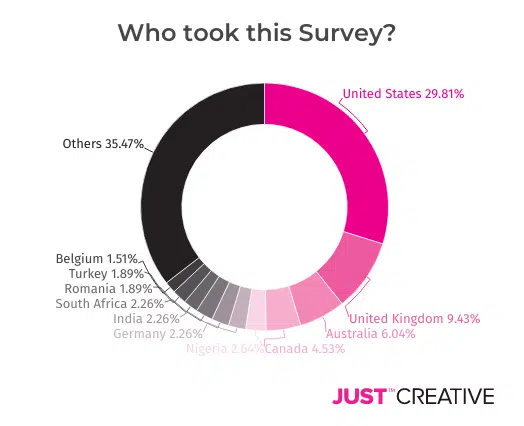
More than half of our survey respondents were self-employed professionals (55.8%), followed by founders (27.7%) and in-house branders (nearly 15%). This trend indicates the growing prominence of independent professionals within the industry.

Of these branding professionals, more than half have 10+ years of experience, while nearly 26% have less than 5 years of experience, and the remaining stand between 5-10 years.
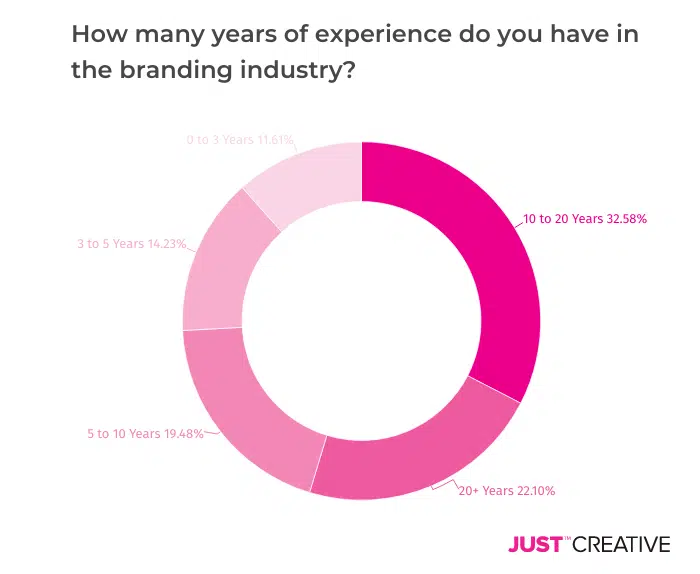
Part of our analysis also included getting a gauge of the sectors branders typically worked in. Our survey respondents represented a wide spectrum of industries.
13%
deliver their services in the Health and Wellness sector, followed closely by Nonprofits and Social Impact at 12%. Tech and Software stood at 11.3%, while Consumer Goods and Retail accounted for 11% of the respondents.
Additionally, our survey revealed a notable presence in the Food and Beverage sector at 9.6%, with Financial Services and Professional Services closely following at 8.4%. Hospitality and Tourism captured 8% of the respondents, while Media and Entertainment represented 7.4%. Lastly, the Fashion and Apparel industry accounted for 6.8% of our survey participants.
Apart from these major sectors, several branding professionals also showcased their expertise in niche industries. We found representation from respondents working in Sports, Construction, Education, and various other sectors, adding further diversity to the branding landscape.

Projects and Pricing
Our survey participants also represent a diverse array of branding projects. The top three types of projects they worked on were brand identity (18.1%), logo design (17.8%), and brand strategy (14%).
Print collaterals, website design, consulting, and packaging projects closely followed the top three, while the remaining spanned across various domains, showcasing the multifaceted nature of their expertise.
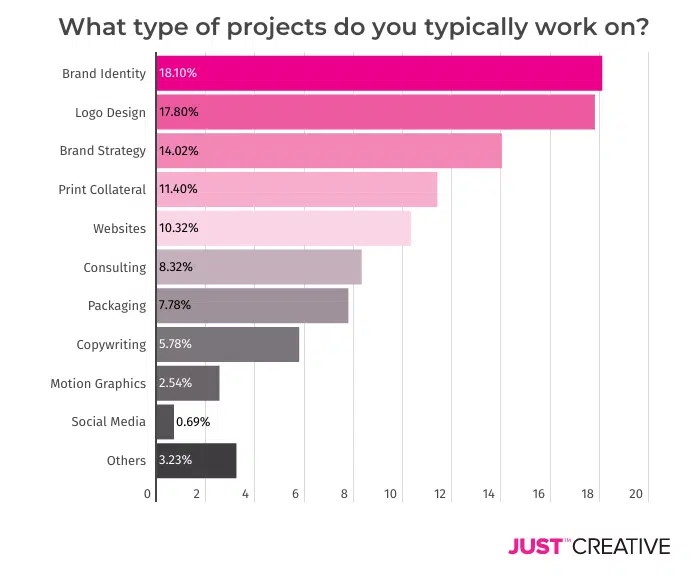
For branding professionals, pricing their projects is not just a financial decision. It is a strategic process that impacts profitability, client relations, brand perception, and overall business growth.
Around half of our respondents priced their projects between $500 and $5k. On the other hand, 18.7% charged less than $500, and 15.4% charged in the range of $5k-$10k.
Only 7.5% of branders reported pricing above $20k for a project, while the remaining 7.5% charged between $10k-$20k.
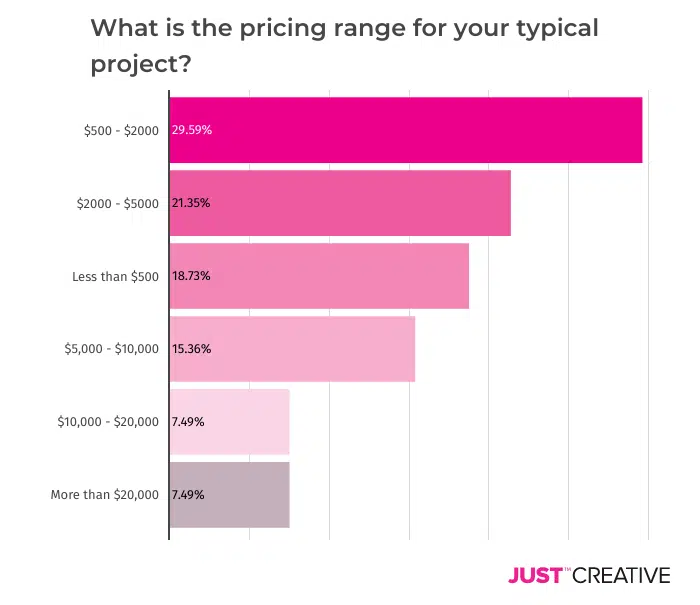
Typically, most of these projects were medium-scale, spanning 4-8 weeks, followed by small-scale projects (28.1%).
Large-scale projects involving 2-4 months of time were reported by 14.6%, while micro-scale projects with a duration of less than 2 weeks followed this. Projects of length over 4 months were the least reported.
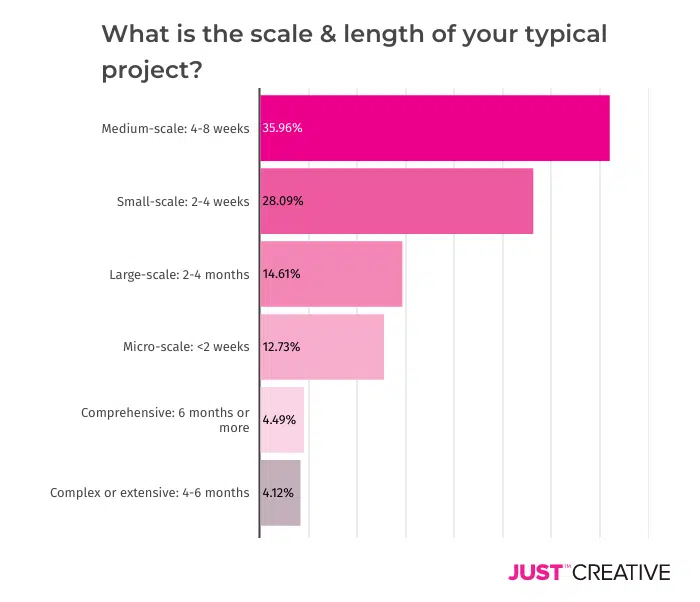
For a clearer picture, we correlated the range and the length of the projects.
Interestingly, nearly half of the people who reported the pricing of more than $20k per project said their projects were either comprehensive, complex, or extensive, involving 4-6 months or more of time. The remaining were large-scale, typically lasting 2-4 months.
Similarly, for the respondents reporting the pricing range of $10k-$20k, 65% of these projects were large-scale or comprehensive. The remaining were largely medium-scale projects of typically 4-8 weeks duration.
For the pricing ranging between $500 and $5k, the length of most of the projects was reported to be small to medium-scale, i.e., between 2 to 8 weeks.
Digging deeper into pricing, the importance of the right pricing model cannot be overstated for independent branding professionals.
When asked about the pricing model, an overwhelming majority reported a fixed pricing model.
69%
opted for a fixed-project-based pricing model, followed by hourly rate billing (36.7%). Only 35.2% selected value-based pricing, highlighting an opportunity for more branders to align pricing with the value they provide.
Interestingly, only 19.9% of our respondents went for the retainer model. Performance-based pricing stood at 7.5%. While complex and risky, equity-based pricing also saw a decent representation (2.2%) in our survey.
These figures suggest that while these alternative pricing models are not widely adopted, they still hold some relevance within the branding industry.
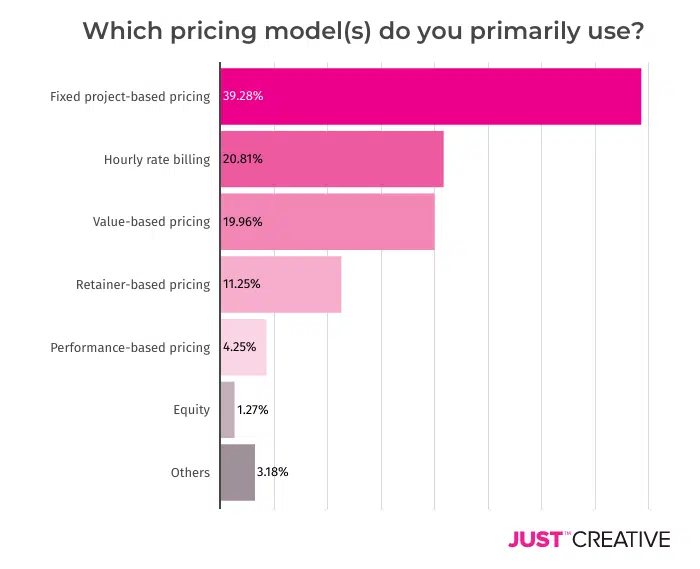
Understanding the intricate interplay between pricing and perceived value is important for branding professionals. Clients often associate higher prices with greater quality and expertise, ultimately influencing their decision-making process.
However, pricing projects is a complex process influenced by various factors. We tried capturing the factors branders typically consider while pricing their projects.
80%
of the respondents consider time and effort as the top pricing factor. Project scope (70.8%) and the brander’s expertise and experience (63.7%) were among the top factors influencing pricing decisions.
Many of our respondents also took value-delivered, client size and market factors, and deliverables and usage rights into account when pricing their projects.
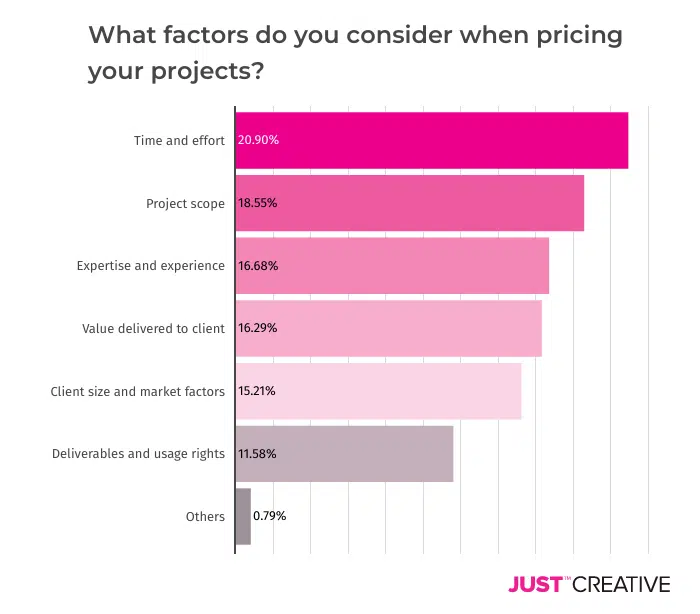
Recommended Resource
If you don’t know what to charge for your creative work, then this course is for you.
In this Pricing Course from Chris Do of The Futur, you will learn how to charge more and profit from every project.
- 26 Videos
- Pricing Guidelines
- Example Bids
- Homework Assignments
- Bonus Material
- Lifetime Updates
For more recommended resources, see our top tools & resources.
—
Metrics unfold the story words can’t. We asked branders how they measured the success of their branding projects.
Our survey showed there’s a lot of measurement happening in the industry. Branders are using a variety of metrics across the board. However, the surprising element was:
34%
of the respondents are still not measuring their success, indicating a potential gap in evaluating project outcomes.
Interestingly, customer satisfaction scores turned out to be the most popular success metric at 39.3%. Also, email marketing turned out to be underutilized as a success metric. Only 7.9% of our respondents used email marketing, suggesting an opportunity for branding professionals to leverage this powerful communication channel.
It’s also interesting to see brand awareness metrics stand at second place among the branders for measuring their project success. Customer perception analysis, referrals and advocacy tracking, social media interactions, website traffic and engagement are among the other notable ones. These point out the breadth of metrics branding professionals can use to evaluate the success of their projects thoroughly.
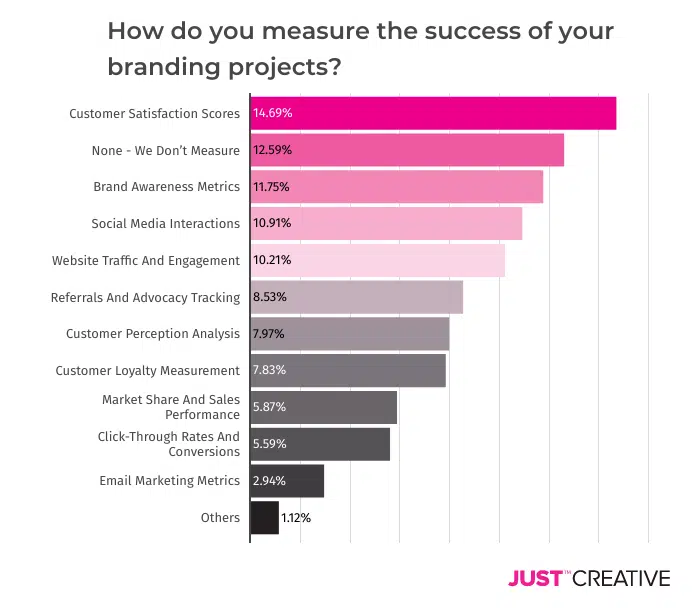
Key Challenges
The world has been undergoing continuous shifts for quite some time now – from the pandemic to evolving technologies and economic downturns. The branding industry, too, has felt the impact of these changes.
In our survey, we asked branding professionals about the key challenges they currently face in the industry post covid. We kept this question open-ended to allow for as much richness as possible in the responses.
As we delved into the responses, a clear pattern emerged, revealing their most pressing concerns. Here are the ones that stood out:
33%
expressed grappling with the issue of getting more exposure, highlighting the importance of visibility and recognition in the industry. Finding new clients and securing new projects stood out as one of the biggest hurdles for branding professionals, with nearly 50% mentioning the same.
- Respondents also stressed the need for more education and awareness among businesses about the broader value of branding beyond visuals, indicating a gap in understanding.
- The pricing structure was another critical area of concern. Branders faced challenges in determining optimal pricing, considering factors like market competition and clients’ perceived value.
- The intensifying competition within the industry, coupled with the growing influence of AI and other automation tools, emerged as yet another major worry.
- Many of our respondents also mentioned how the economic downturn had affected their growth due to clients cutting budgets.
- Many also highlighted the difficulties in measuring the success of their projects, underscoring the need for implementing robust measurement strategies.
The word cloud below visually captures the key challenges mentioned by our survey participants.
Key Challenges in the Industry
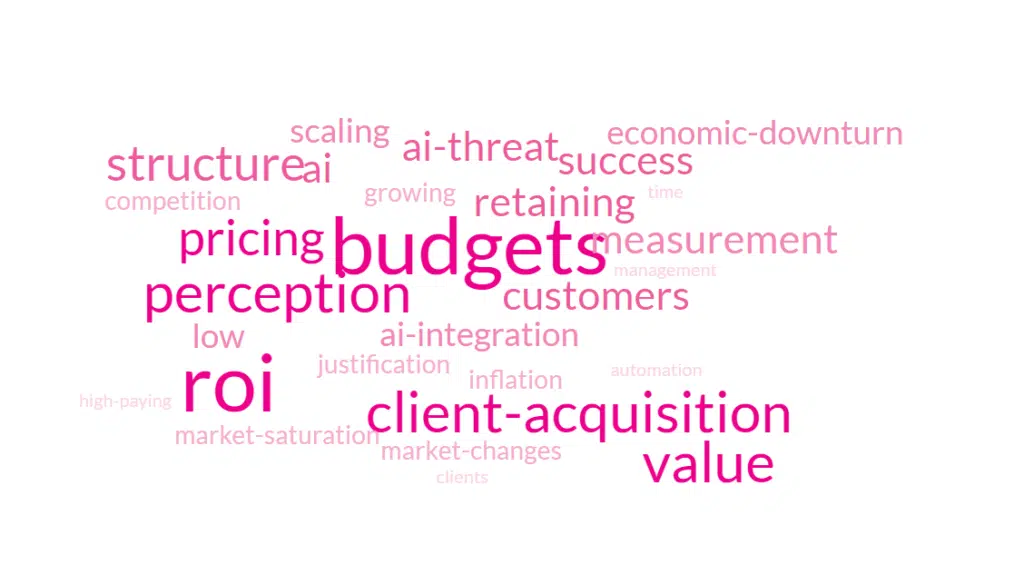
Some of the quotes by our respondents further give us a glimpse into the challenges the industry is dealing with:
“There is no market drive to spend on brand because there is a lack of understanding about brand. Businesses jump more readily to marketing which they understand better. I get called marketing which I’m not. Marketing people are calling themselves brand marketers, which confuses clients even more.”
“People are seeing the value of hiring a designer less and less. First, it was Fiverr, then Canva, and now AI. It’s hard to sell web design, too, when you can DIY an ok site with Squarespace or, again, AI.”
“Canva is another potential branding and creative agency killer, I was very reluctant to adopt it, but finally succumbed after Canva Create’s major update back in March. More clients complete design work in-house once initial branding, brand assets, and brand guides are delivered. Makes total sense financially for them.”
Client Acquisition
We had foreseen that acquiring clients would be a significant challenge for branding professionals. And our survey confirmed that.
Client acquisition is more than just finding clients and pitching to them. It demands creativity, strategy, and perseverance. We were eager to discover the tactics branders are using to expand their clientele.
Our survey participants offered some valuable insights into their client acquisition strategies.
86%
of our respondents relied on referrals and word of mouth (86%) for getting new clients, followed by networking and relationship building (71.5%). These statistics highlight the significance of personal connections in the industry.
Collaborating with other professionals at the third spot is a super interesting insight. This may be a really effective way to get more clients. SEO is another powerful tool that can significantly enhance branders’ online visibility, accessibility, and overall reach.
Only 24% of branders using SEO shows there’s so much left for branders to tap into.
The other tactics include social media marketing, email marketing, targeted advertising, attending industry events and networking, utilizing online marketplaces, and guest speaking or conducting events, among others.
By integrating a mix of strategies, branding professionals can optimize their ability to connect with their target audience and build a robust presence in a competitive landscape.
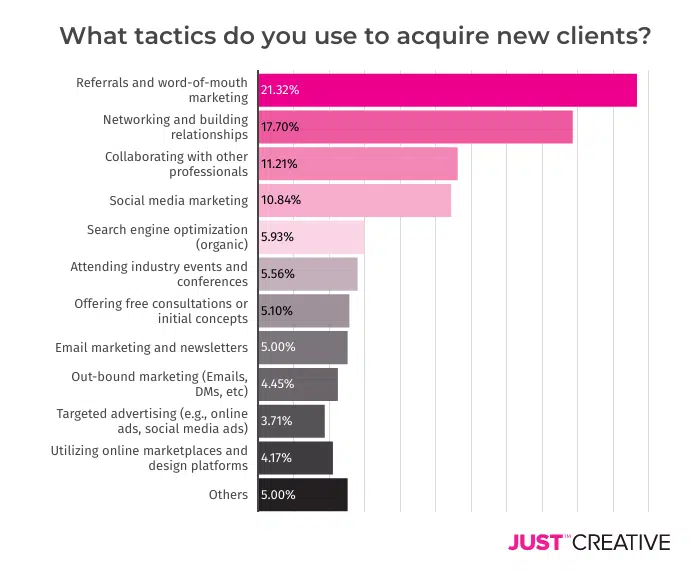
When asked to choose the ONE client acquisition tactic, referral and word of mouth was the #1 choice once more, followed by networking and building relationships.
This could possibly be stemming from the rapport they’ve built with current clients. The relative simplicity of the referrals compared to other tactics may be another factor.
Recommended Resource
This six suite course bundle covers everything from finding clients to managing your creative business.
It includes 6 courses, 40+ hours of videos, 174 lessons, 60+ downloadable templates, literally EVERYTHING you need to run your creative business profitably and enjoyably!
- Six mega courses
- 40+ hours of content
- 60+ downloadable resources
An interesting thing to note is that 15% of respondents chose targeted advertising as a tactic, yet only 5.99% of the respondents chose it as the one client acquisition tactic.
While an alarming 20.6% of branding professionals selected using free consultations as a tactic, it’s clear it is not their preferred way. Only 0.37% of the respondents chose free consultation as the one tactic they’d prefer to acquire new clients.
Check out the ranking of preferred tactics in the chart below:
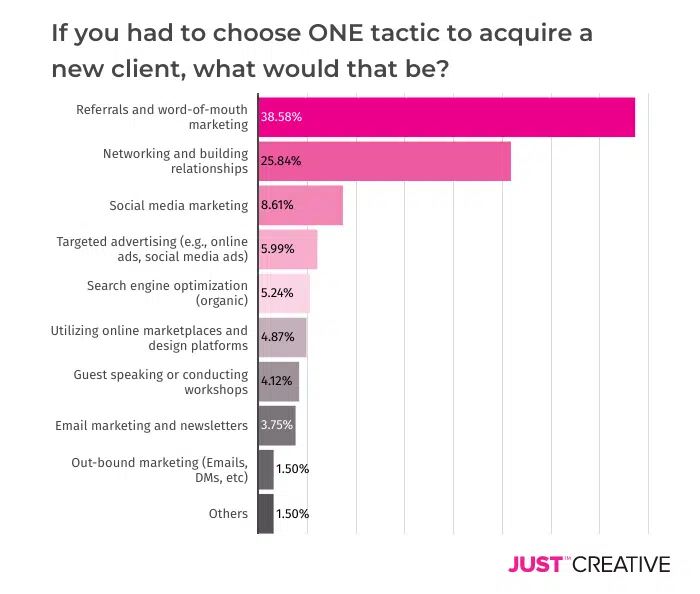
Whatever may be a brander’s client acquisition tactic, setting themselves apart from the competitors is fundamental to achieving success.
90%
emphasized that the experience they provide to clients stands out as their primary differentiating factor. Additionally, they highlighted their in-depth knowledge, which adds value to their services.
Moreover, many respondents emphasized their niche specialization, well-defined process, and unique design style as key elements that set them apart. Other significant qualities mentioned include communication skills, strategy, value for investment, holistic branding approach, problem-solving ability, and focus on sustainability.
Furthermore, some respondents highlighted their ability to work with small businesses, affordability, and client-centricity as unique features of their services. The wide range of differentiating strategies indicates that a multifaceted approach is necessary to distinguish oneself in a competitive environment.
This word cloud visually captures the diverse range of responses:
How Do Branders Differentiate Themselves?
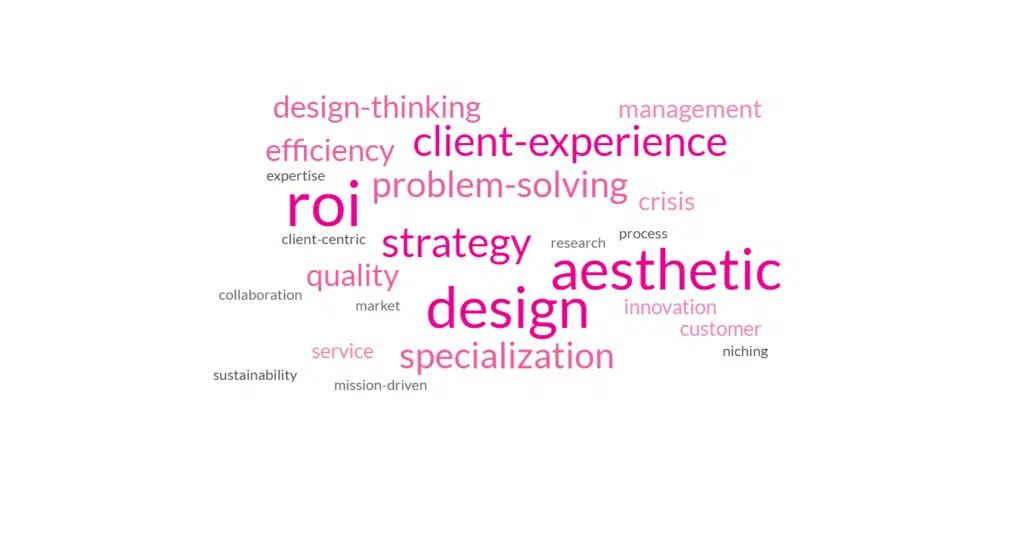
Here’s what some of our respondents shared regarding differentiating themselves:
I have a Master’s degree and a PhD in Emotional Design, and I am a specialist in Neuroscience and Behavior. Today, I work with an exclusive brand strategy method that associates these and other areas of knowledge.
Extensive and in-depth brand discovery sessions paired with a hands-on design process with every client. The entire experience feels like a group project as opposed to a “done for you” offer.
My holistic branding approach doesn’t just concern itself with the design of the brand but the brand as a whole as well as my design aesthetic.
A cohesive brand identity that stretches beyond just a logo or design. Our branding permeates every aspect of a company and its operations.
My clients truly “enjoy” working with me, and the enthusiasm and industry experience I bring to their projects. I have no ego problems, a great sense of humor, and an unwavering work ethic to deliver the absolute best work I can produce.
While my branding and website business is young(ish), I have around 30 years of design experience, starting as a jeweller. I have niched fairly well, so I understand my client base and what appeals to them.
Amidst the ever-changing and unpredictable market, there is a growing focus on the value of diversifying income sources for professionals. Through additional earning avenues, they can achieve financial security, seize new opportunities, and build a resilient career.
Diversifying income streams can not only safeguard against the uncertainties of the market but also open doors to previously untapped possibilities, securing their overall professional journey.
We asked our respondents how else they earn online. They are exploring a number of income sources.
19%
of branders are making money through consulting, followed by selling digital products (16.4%). However, a large number (16.2%) said they don’t have additional earning streams.
Furthermore, merely 7% have ventured into offering an online course, showing a relatively unexploited potential for knowledge monetization.
Furthermore, it’s worth noting that a mere 2% of branding professionals currently generate income through advertisements. This statistic underscores the unexplored opportunity for branders to delve into advertising as a potential avenue for amplifying their earnings.
Check out other income avenues adopted by branders in the chart below:
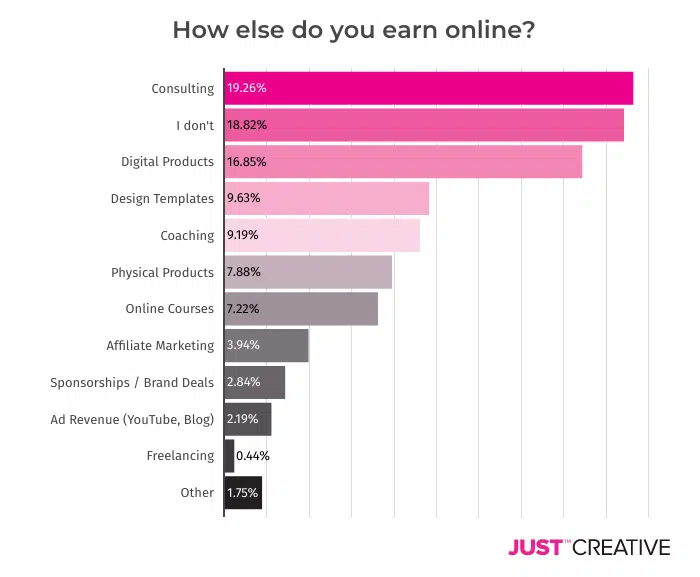
AI and the Future
The influence of AI is growing across industries, and branding is no exception. From streamlining design processes to speeding up data analysis, AI has the potential to reshape the way branders work. (See our list of top AI tools for business)
However, with AI potential also come questions about its implications for creativity, job roles, and the overall human touch in branding strategies.
We aimed to uncover the sentiments of branding professionals around AI and how they see it impacting their work. A vast majority of our respondents (70.4%) believed AI would make their life easier.
Despite AI’s potential benefits, some branders expressed concerns about its impact on devaluing human expertise and creativity in the branding process.
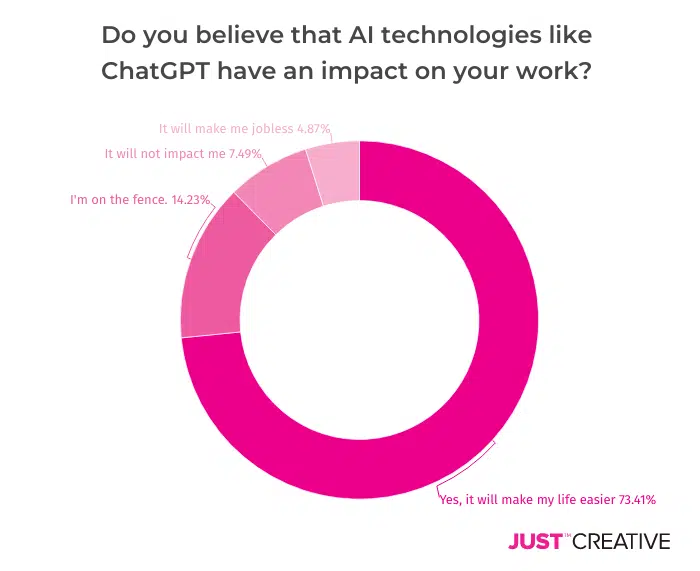
The following statements from some of our survey participants capture the viewpoints of branders about AI:
It feels like it gets more competitive year on year. AI is an obvious threat to many industries, including the creative sector – embrace the tools or get left behind is my philosophy.
I have mixed feelings. For one part, yes, it can help me facilitate my work, but it won’t fully substitute my work tools. On the other hand, there are people that are automating their work and lessening the value of people like me.
Absolutely! We have been integrating AI into all our daily roles. I have also included a ChatGPT AI Generative Brand Design workshop in our academy this year.
Embracing AI as an ally has also come out as a theme from our survey. Most of our respondents reported integrating AI tools like ChatGPT (70.4%), Adobe (beta) Software (32.6%), and Midjourney (22.5%) into their workflow.
Adobe Firefly, DALL-E, Figma, and Design.ai also have quite a few takers. Additionally, AI copywriting tools such as Jasper, Copy.ai, and Writesonic were also mentioned by some respondents. See
20%
of branders in our survey are yet to embrace any AI tool, presenting an opportunity for them to explore and integrate AI technologies into their branding practices.
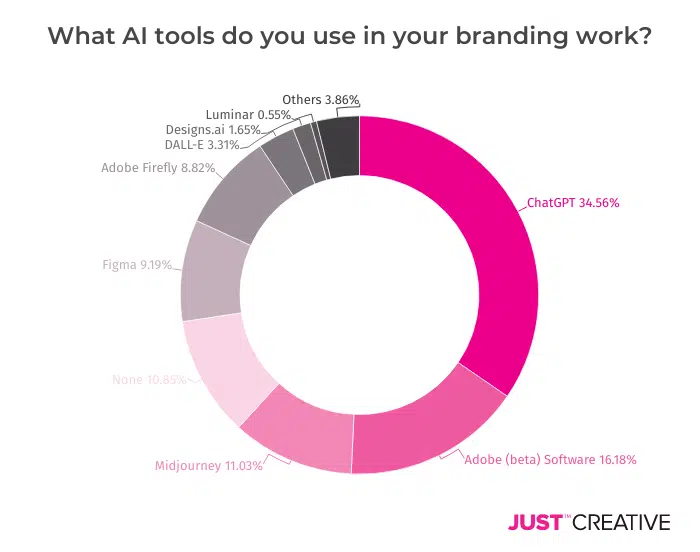
When it comes to the future of branding, especially in the context of AI, this quote by one of our respondents conveys the prevailing sentiment – the human touch is here to stay.
It will make selling our expertise more important. It may mean fewer of our lower-tier clients, but it should not impact the number of our dream clients since they value the strategy and human touches of working with us.
74%
considered authenticity to be the most important for the future of branding, followed by personalization (58.8%) and purpose-driven branding (57.3%).
Sustainability and ethical branding (56.6%), emotional branding (49.4%), technological integration (28.1%), experiential marketing (25.1%), and data-driven insights (21.3%) are among other notable considerations. These emphasize the growing importance of creating meaningful and emotionally resonant brand experiences.
Check out all the factors our respondents consider important for the future of branding in the chart below:
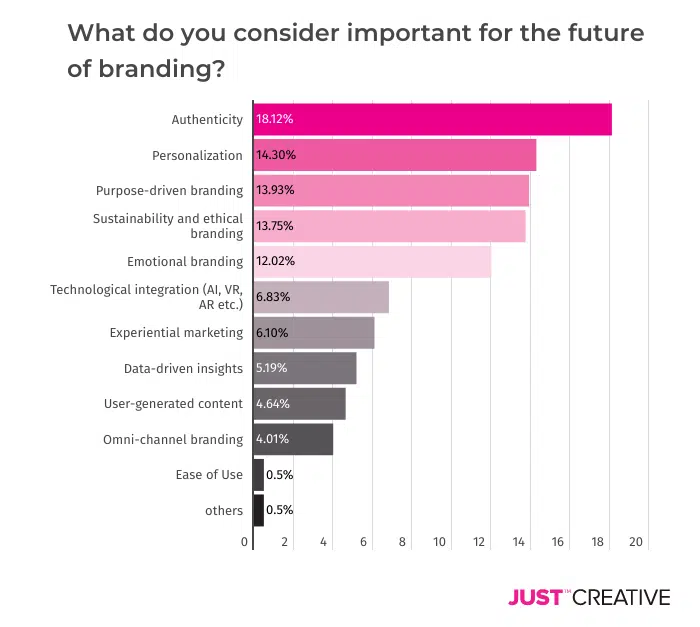
Top 10 AI Tools
We’ve sifted through the junk and selected the crème de la crème AI tools.
- ChatGPT — Best AI ChatBot & Best AI Tool Overall (Try these advanced Prompts)
- Jasper — Best AI Copywriting Tool
- Luminar — Best AI Photo Editing Software
- MidJourney — Best AI Art Generator (or Try Canva AI Free)
- Synthesia — Best AI Video Tool
- Looka Logo Maker — Best AI Logo Maker & Branding (Still a long way to go)
- Business Name Generator — Best AI Naming Tool
- Wix ADI — Best AI Website Builder
- Shutterstock Generator — Generate licensable AI stock art – Get 10 Free!
- Originality AI — Best Plagiarism Checker & AI Detector
See here for our complete list of AI tools for business, design & marketing.
Business Tools
Branders are increasingly recognizing the importance of the integration of tools in their workflow. For independent branding professionals and agencies, the right tools for business management are equally essential.
As expressed by one of our survey participants, the quote below sums up the prevailing scenario around the tools:
Another challenge for a small agency (or freelancer) is knowing which tools/software to trial and then invest in to benefit both the agency side and the client side.
Not only are there a myriad of design tools (mostly dominated by Adobe), but considerations around project management and workflow, communication tools, file storage and sharing, admin and finances, social media and email marketing, website development and page builders, etc. – all of this research takes time and money!
Not surprisingly, Adobe Creative Suite is used by almost 90% of our survey participants. Design tools like Figma, Procreate, Sketch, and Corel also have decent representation.
Though not usually preferred by branding professionals, Canva (38.6%) is gaining ground – possibly because clients prefer easy-to-edit templates and assets. This likely indicates a shift towards accessible and user-friendly design platforms.
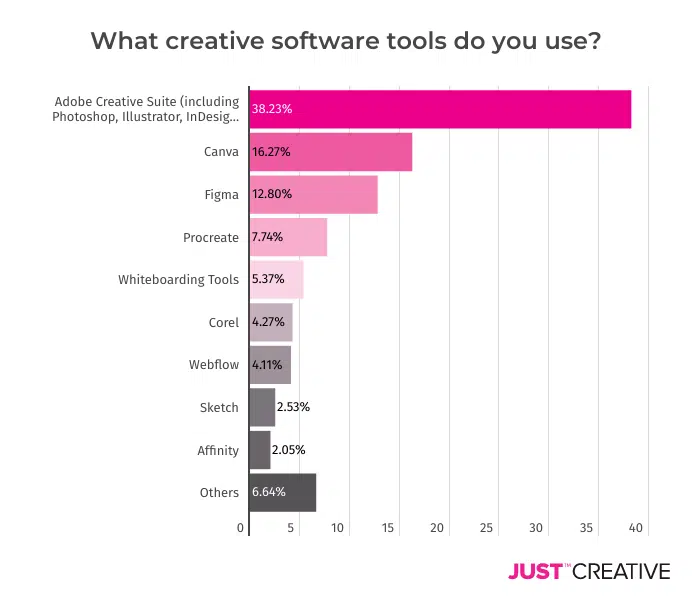
As far as the stock websites are concerned, Unsplash, Pexels, Freepik, Adobe Stock, and Shutterstock are among the top choices for our survey respondents.
Check out all the stock websites branding professionals like to use in the chart below:
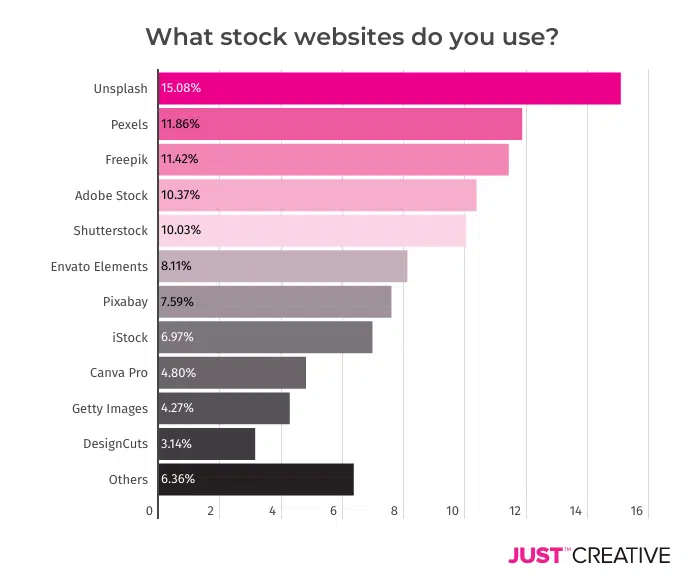
For business operations, our respondents used a wide range of tools. The payment tool PayPal (47.6%) and the accounting tool Quickbooks (14.6%) were the most popular among our respondents, highlighting the requirement for streamlined and efficient tools for business growth.
Similar tools like Wise, Xero, Monday.com, Notion, and Dubsado saw a strong representation in our survey.
Explore the different business tools branders use in this chart:
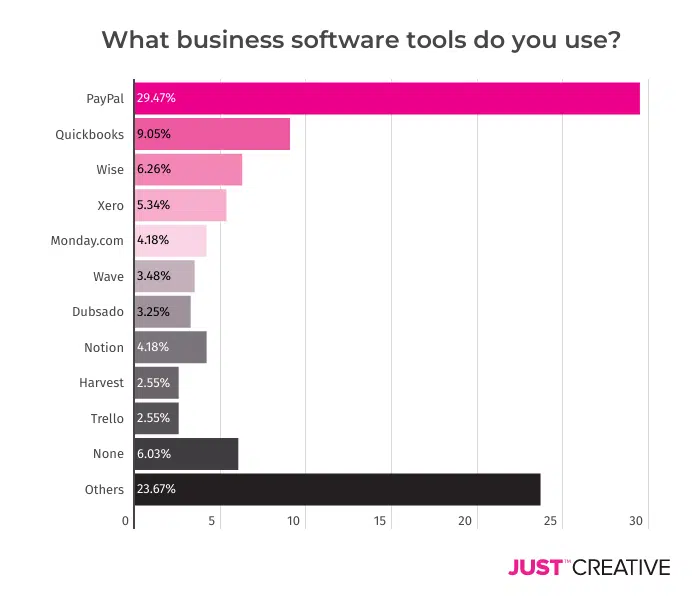
As the world of branding gets more complex, legal implications can significantly impact branding strategies. Compliance with legalities is no longer just a good thing but a necessity.
We wanted to gauge if the branders feel confident about this aspect. Turns out, only 6.4% of our survey respondents rated themselves 5 out of 5 on their knowledge about intellectual property, copyrights, etc.
40%
of the respondents rated themselves between 0 and 2 on a scale of 5. The majority featured somewhere in the middle, rating themselves a 3 out of 5.
The relatively low confidence level in understanding the legal aspects of branding highlights the need for increased awareness and education in this area.
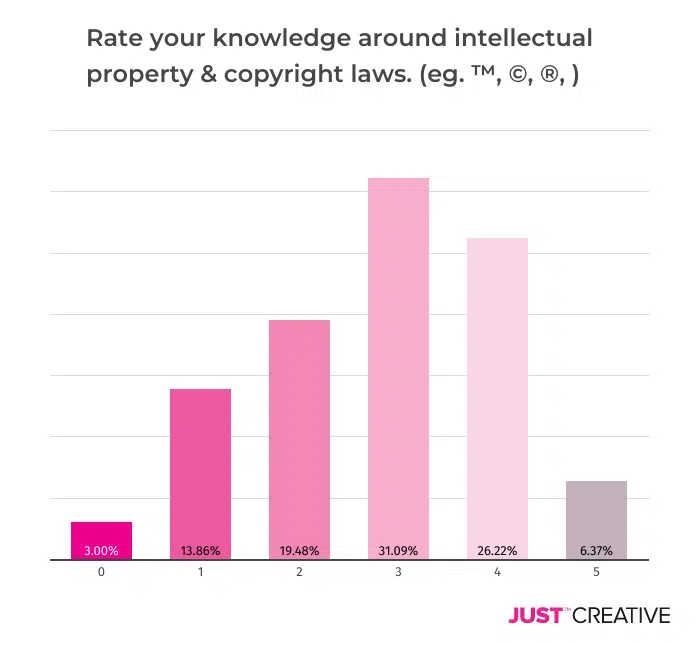
Learning and Development
To keep pace with the shifting trends, technology advancements, and consumer behavior, continuous learning is essential for any professional’s growth. Our survey shows branders are prompt in seeking feedback and improving their capabilities for their professional growth.
90%
of branders are turning to clients for feedback. A large number (67.8%) of them also rely on self-reflection, and analysis and feedback from friends or peers. Many of them also turn to senior co-workers and online communities for learning.
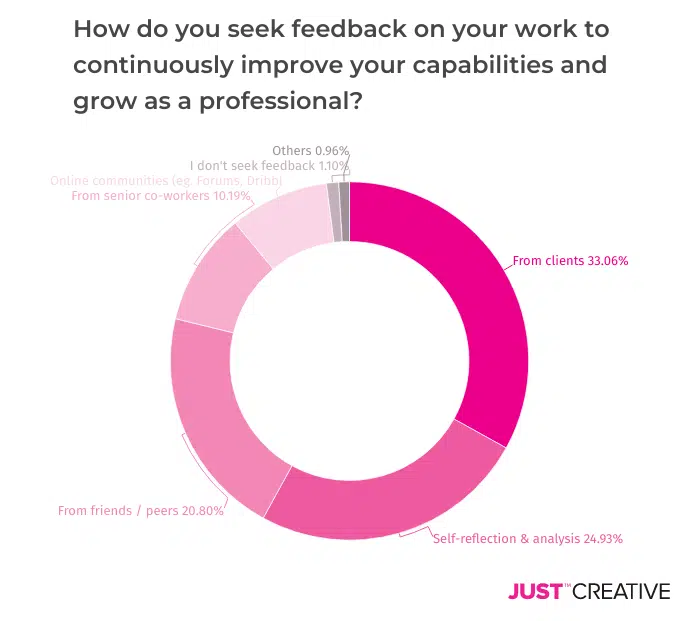
When asked to recommend the resources they prefer for enriching skills in branding, we got a huge list of resources across categories – books, social media influencers, mentors, online blogs and newsletters, and more.
The endorsement of these resources underscores the instrumental role of industry leaders in shaping the learning journey for branding professionals.
Learning Resources
A list of some of the most recommended ones by our respondents:
- Courses by The Futur, Brand Master Academy, Jacob Cass and online course platforms like Skillshare, Coursera, and Domestika.
- Blogs and Online Publications – JUST Creative; How Brands are Built; Brand New; Creative Boom; and Communication Arts
- Email Newsletters – The Futur, Just Creative, Seth Godin, and Rob Meyerson
- Books – The Brand Gap by Marty Neumeier; Designing Brand Identity by Alina Wheeler; Purple Cow by Seth Godin; ZAG by Marty Neumeier; and How Brands Grow by Byron Sharp
- Mentors / Influencers – Chris Do, Marty Neumeier, Seth Godin, Jacob Cass, Michael Janda, Stephen Houraghan, and Mark Ritson
- Podcasts – A Bit of Optimism, JUST Branding, Online Marketing Made Easy, The Futur Podcast, and Let’s Talk Branding (See more top Branding Podcasts)
Key Takeaways
Here are some suggestions on how to apply these insights to propel your career forward in 2024 and beyond.
01
Refine Pricing Strategies and Diversify Income
Diversify your pricing strategies beyond time and effort. While nearly 80% of branding professionals price their projects based on time and effort, consider exploring value-based pricing (used by only 35.2% of respondents) to align your rates with the value you provide.
02
Proactively Acquire Clients and Foster Valuable Networks
While referrals and word of mouth are the primary methods for acquiring clients (86.1% of respondents), invest in networking and building relationships (71.5%) to expand your client base. Don’t solely rely on referrals.
03
Integrate AI with a Human-Centric Approach
Embrace AI tools (integrated by around 70.4% of respondents) like ChatGPT, Adobe’s AI tools, and Midjourney to streamline your work processes. However, maintain the human touch in branding experiences, as clients value strategy, emotion, and personal interaction.
04
Embrace Authenticity in Future Branding
To stay relevant in the evolving landscape, consider focusing on authenticity (74.5%), personalization (58.8%), and purpose-driven branding (57.3%) in your strategies.
05
Navigate Industry Challenges and Adapt with Agility
Address industry challenges such as finding new clients, educating clients about branding’s value, pricing structure, increasing competition, and the influence of AI. Be adaptable and invest in continuous education to navigate these challenges effectively.
06
Optimize Project Evaluation Metrics
To measure project success, incorporate customer satisfaction scores (39.3%) and brand awareness metrics. Consider utilizing underutilized metrics like email marketing (7.9%) to enhance your project evaluation.
07
Expand Income Streams Strategically
Explore additional income avenues such as consulting (18.8%) and selling digital products (16.4%) to enhance your financial stability and business growth. Consider offering online courses (only around 7% do this) to tap into knowledge monetization.
08
Optimize Tool Selection and Adaptation
While Adobe Creative Suite remains a popular choice (used by 90% of respondents), consider exploring emerging design tools and platforms that align with industry trends and client preferences. Keep an eye on user-friendly platforms like Canva (38.6%), which are gaining popularity for their accessibility.
09
Strengthen Legal Knowledge and Awareness
Invest time in improving your understanding of legal aspects related to branding, including copyrights and intellectual property rights. Approximately 40% of branding professionals feel less confident about their legal knowledge.
10
Prioritize Continuous Learning and Skill Growth
Prioritize continuous learning by seeking feedback from clients (90%) and utilizing various resources such as courses, publications, and industry influencers. Stay proactive in enhancing your skills.
11
Align Project Variety with Pricing
Diversify your project types based on your expertise and client needs. For larger projects, consider aligning your pricing accordingly. Those who price projects over $20,000 often reported comprehensive, complex, or extensive projects lasting 4-6 months or more (50%).
12
Strategically Differentiate for Market Impact
Set yourself apart by enhancing client experience (90%), niche specialization, process innovation, and developing a unique design style. Tailor your differentiation strategy to your strengths.
Conclusion
We want to thank all the branding professionals who took the time to participate in our survey and contribute such valuable responses.
These insights will undoubtedly help us stay ahead of the curve and progress in our branding profession.
Branders are embracing AI, focusing on authenticity, and seeking growth through diversified income streams and continuous learning.
- What is your takeaway from this report?
- What is one action you can do today?
Download the PDF
Update October 30: After many requests, we have now made a PDF printable version of the report. You can access the PDF report in our Branding Briefcase. Simply enter your email below.
Share The Report
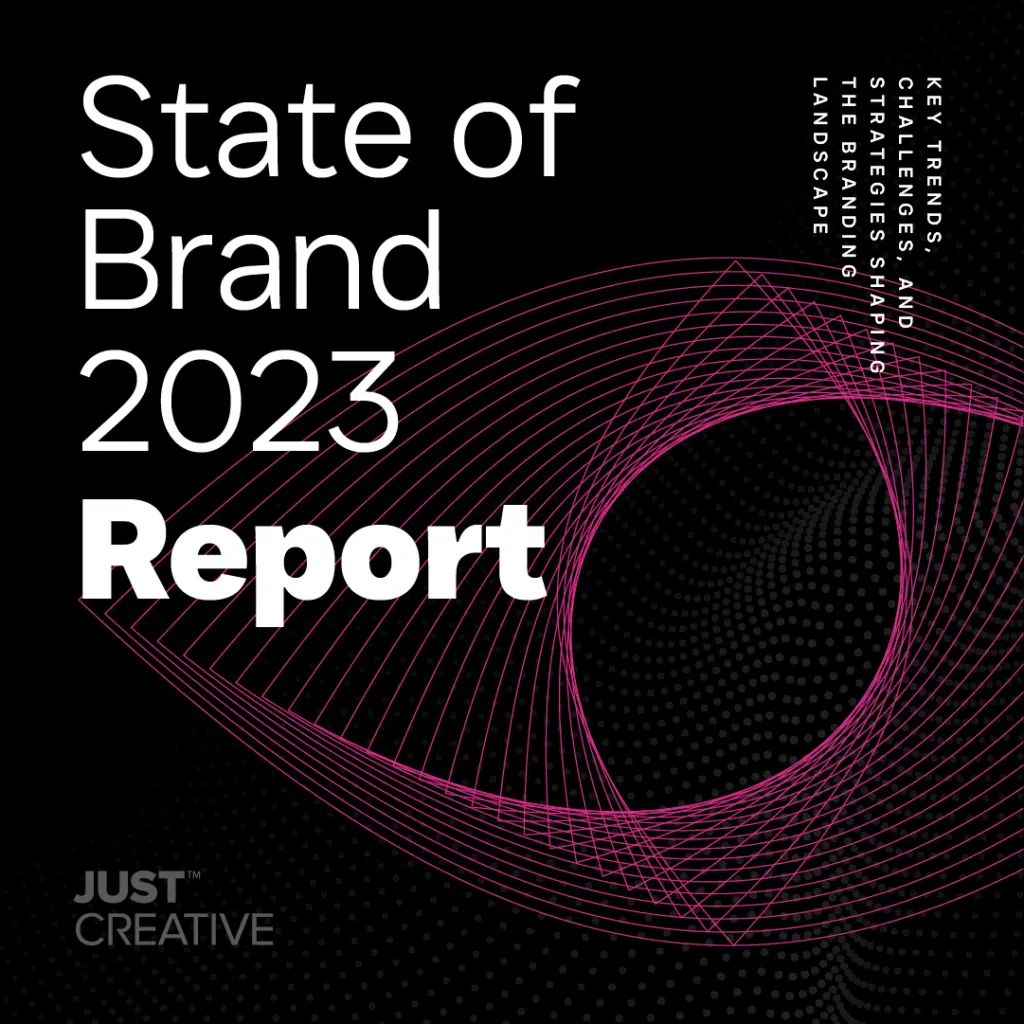
Please consider sharing this within your network to broaden its reach. We’ve provided graphics and accompanying copy for your convenience:
🚀 The State of Brand 2023 Report is here!
Get the latest industry insights and strategies to elevate your #branding game!
📈 https://justcreative.com/state-of-brand-survey/
